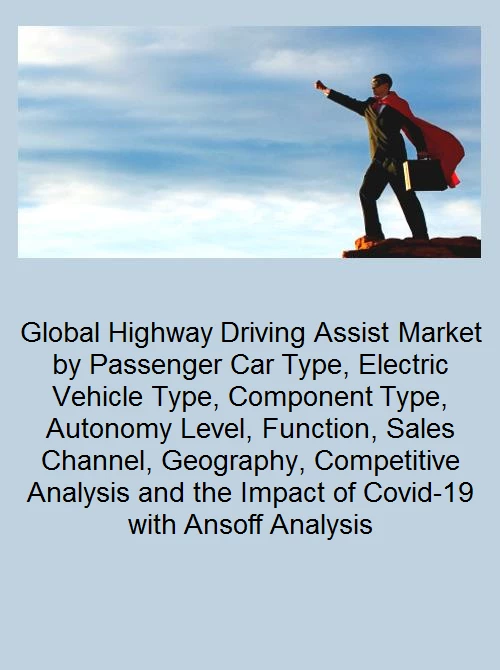The Global Highway Driving Assist Market is estimated to be USD 2.27 Bn in 2020 and is expected to reach USD 6.22 Bn by 2025, growing at a CAGR of 22.3%.
Market Dynamics
Key factors such as long monotonous driving situations especially on highways can lead to driver fatigue and potential road accidents. The driver assists feature enables the driver to assist in driving by controlling the vehicle’s steering, acceleration, and deceleration functions, thereby reducing highway collisons and providing a smooth driving experience. This has led to the growth of the highway driving assist market.
However, the implementation of the software leads to the high cost of such technology. Also, the issues related to lane centering has led to limited user acceptance restraining the growth of the market.
Market Segmentation
The Global Highway Driving Assist Market is segmented further based on Passenger Car Type, Electric Vehicle Type, Component Type, Autonomy Level, Function, Sales Channel, and Geography.
By Passenger Car Type, the market is classified as mid-Segment and Luxury Segment. Amongst the two, the mid-Segment passenger car type segment is estimated to hold the highest market share.
By Electric Vehicle Type, the market is classified as BEV, HEV, PHEV and FCEV. Amongst all the BEV segment is estimated to hold the highest market share during the forecast period.
By Component Type, the market is classified as Camera, Radar, Ultrasonic Sensor, Software Module and Navigation. Amongst all, the Software Module segment holds the highest market share.
By Autonomy Level, the market is classified as Level 2 and Level 3 & above. Amongst the two, the Level 3 and above segment is estimated to hold the highest market share.
By Function, the market is classified as adaptive cruise control, lane-keeping assist, lane centering assist and collision avoidance assist. Amongst the two, the adaptive cruise control segment is estimated to hold the highest market share.
By Sales Channel, the market is classified as OEMs and Aftermarket. Amongst the two, the OEMs segment is estimated to hold the highest market share.
By Geography, North America is projected to lead the market.
Recent Developments
- Hyundai Motor Group has developed a machine-learning based Smart Cruise Control (SCC-ML) technology for integrating the driver’s patterns into its self-driving behaviour. This technology also aims to incorporate the Highway Driving Assist system to assist in automatic lane change and help achieve the SCC-ML a level 2.5 self-driving – 21st October 2019
- Nvidia Corp plans to enter the self-driving technology to assist the cars with automated lane-keeping, cruise control, and other driver-assistance features. This shall be done by utilizing the “Orin” processing chip used for the vehicles under production by 2023.- 14th May 2023
For more information, visit https://www.researchandmarkets.com/reports/5304388/global-highway-driving-assist-market-2020-2025.


